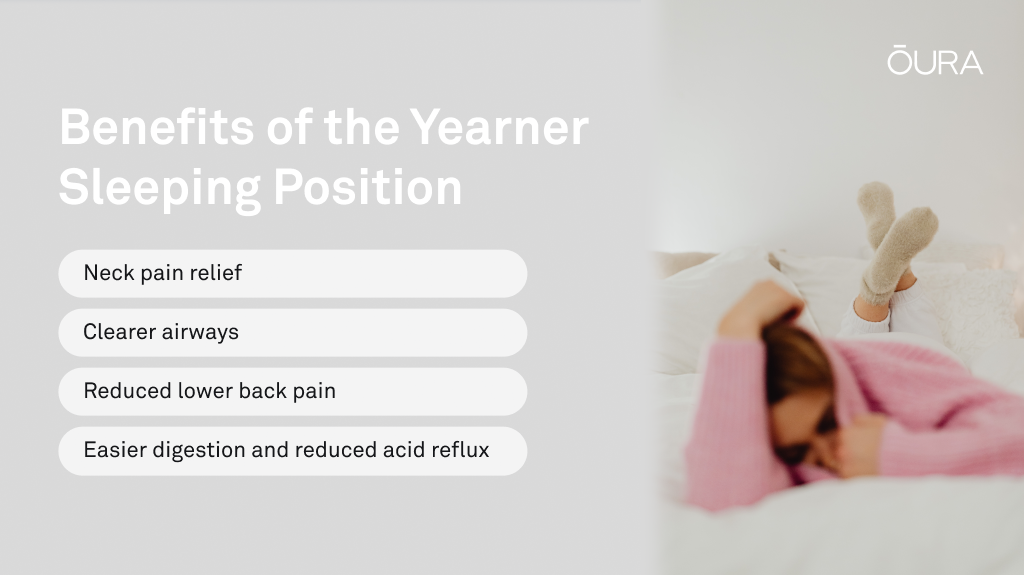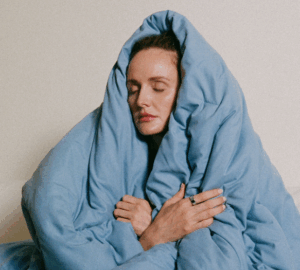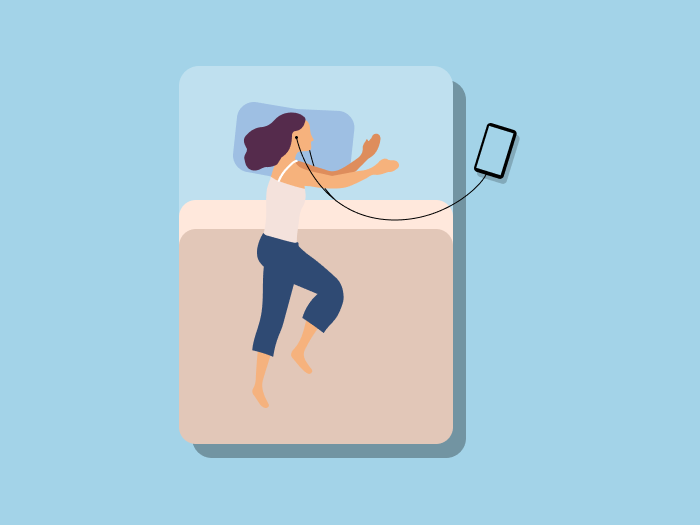While we all have a way of resting that feels the most comfortable, it’s important to understand whether your sleeping position is the best choice for your health and well-being.
Below, we’ll explore the yearner sleeping position — aka sleeping with both arms outstretched — including the benefits, the drawbacks, and misconceptions.
What is the Yearner Sleeping Position?
The yearner sleeping position is categorized by various traits. If you haven’t thought about your preferred pose before, does any of this sound familiar?
-
- A straight back
- Legs slightly bent at the knees
- Extended arms, as if reaching for something
If it does, you might be a yearner.
According to research on the connection between personality traits and position, one sleep expert found that you might be cynical, suspicious, and an open person if you sleep like this. Interesting, right?
There is, of course, no sufficient research to ground these claims, and your identity should never limit, nor be limited by, your range of sleep positions. You are free to snooze however you’d like to.
RELATED: 8 Popular Sleeping Positions: Find Out What They Mean for Your Health
Moral of the story: There is no one-size-fits-all for everyone. Oura understands the importance of identifying your own sleep style, which is why the Oura Ring analyzes over 20 biometrics, such as temperature and heart rate, to tell you how ready you are for the day — delivered as your daily Readiness Score.
Benefits Of The Yearner Sleeping Position
Benefits of the yearner sleeping position may include:
- Neck pain relief: The yearner helps you to align your spine and keep your neck in a neutral position, which acts to reduce soreness.
- Clearer airways: When you sleep on your side, you open up your airways and allow for better airflow. This can be a huge relief if you’re a frequent snorer, suffer from sleep apnea, or have breathing difficulties. If you suspect you might have breathing problems at night, use Oura’s Blood Oxygen Sensing feature to monitor your oxygen levels — if they drop below 95%, you may need to speak to your healthcare provider.
- Reduced lower back pain: A hurting back can impact your sleep quality and can affect you throughout the day. The yearner position helps maintain the natural curvature of the spine, reducing the risk of discomfort.
- Easier digestion and reduced acid reflux: Experiencing problems with digestion can impact your sleep and be uncomfortable during the day. According to Dr. Rachel Salas, Associate Professor of Neurology at Johns Hopkins Medicine, sleeping on your left side can reduce symptoms of acid reflux.

Drawbacks Of The Yearner Sleeping Position
While the yearner can be beneficial for your body, it can also have some drawbacks, depending on your personal physiology. These are not problems for everyone to worry about, but they may have consequences for your health, particularly if you have trouble with your hips. Potential downsides include:
- Risk of wrinkle formation: Sleeping on your side can lead to an increase in wrinkles over time. This is because your face is in contact with the pillow, which causes the skin to fold and form lines. If this is something that would bother you, it may be better to sleep on your back.
READ MORE: How Does the Soldier Position Impact Sleep Quality?
- Increased hip discomfort: Due to the specific positioning of the legs, the top gets less support than the bottom. As a result, you could find that your hips start to give you some grief. Those with aggravated joints may be more comfortable as back sleepers.
- Sore arms and shoulders: It’s never pleasant waking up with numb limbs after falling asleep in an awkward way. The yearner can cause this feeling because the arms are extended. The Healthcare Associates of Texas claim that stomach sleeping, such as the freefall position, eases shoulder pain.
READ MORE: Why Do I Sleep With One Leg Bent Up? The Half-Stomach Position

Common Misconceptions About The Yearner Sleeping Position
Even if you sleep in the same way as the person next to you, you won’t always have the same experience. The yearner position won’t affect us all in the same way, as there are usually other influences. Generalization leads to misconceptions, such as the ones below.
- The yearner causes neck and back pain. Some positions can lead to discomfort but, typically, the yearner isn’t one of them.
- Yearners are prone to snoring. How a person sleeps does not directly cause snoring, though it can sometimes exacerbate it. This is more often found when an individual is back sleeping, has consumed alcohol, or has a cold or flu. The good news is that being on your side in the yearner position doesn’t worsen the symptom and can even ease it.
- The yearner involves side sleeping only. Though this is usually the case, it is also possible to instead adopt a semi-reclined posture. The primary characteristic of a yearner is the outstretched arms.
How to Improve Your Sleep In The Yearner Sleeping Position
If you feel like you’re not getting high-quality sleep, consider using a wearable like the Oura Ring, which tracks your quality of sleep. For example, you can use Oura’s Nighttime Movement Feature to find out if you’re sleeping restlessly or moving around a lot during the night.
RELATED: Restless Sleep? How to Reduce Tossing and Turning at Night
You may find that your body is just naturally drawn to the yearner. If that’s the case, there are various ways you can make it the best sleeping position for you.
- Place a pillow between your arms or under your elbows. If you find this position is causing you arm and shoulder pain, consider trying this trick next time you doze off. It will alleviate the strain on the body, particularly if you often lay with your arms above your head. A side sleeping position is also best for pregnant women, so for additional comfort, place a pillow under the stomach or knees.
- Find the best mattress for you. Your mattress plays a huge role in getting a good night’s sleep, so try adjusting the firmness of yours. It’s important to find the right balance for you, but a medium-firm one is suitable for a yearner because it provides ample back, neck, and shoulder support.
READ MORE: How to Choose the Best Bedding for a Better Night’s Sleep
- Investigate the other influences. You may find there are other reasons you aren’t getting quality rest or enough sleep. Use measures like the Oura Sleep Score to find out if a certain activity or an indulgence in caffeine is the real culprit.
- Upgrade your sleep hygiene. Regardless of positioning, there are practices that everyone should implement into their bedtime routines. This includes ditching the screens an hour before bed, avoiding exercising too late in the day, and limiting naps.
READ MORE: 5 Ways to Upgrade Your Sleep Hygiene










